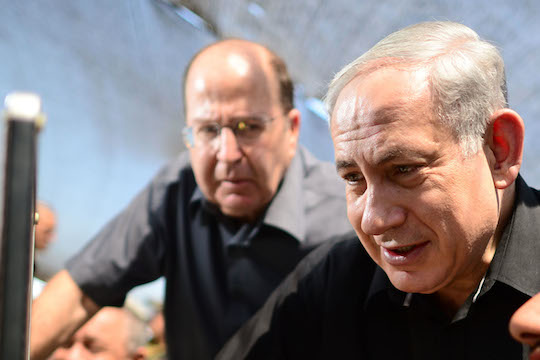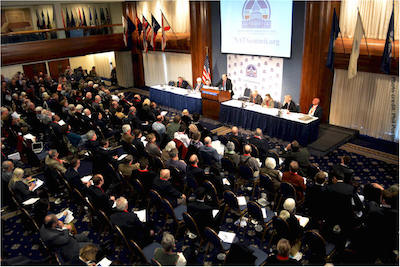The Contrived Iran Threat: Another phony excuse for endless war
Mar 1 2016 / 3:14 pm
Iran was not building a nuke and much of the information used to bolster the argument being made turned out to be fabricated by the Israelis themselves… Iran may be many things depending on one’s perspective, but it is not a global or even much of a regional threat.
By Philip Giraldi
The Israeli Minister of Defense is now telling anyone who is willing to listen that the Iranian government is building an “international terror network that includes sleeper cells that are stockpiling arms, intelligence and operatives to be ready to strike on command in places including Europe and the U.S.” Moshe Yaalon elaborated that Iran intends to destabilize the entire Middle East as well as other parts of the world and is “training, funding and arming ‘emissaries’ to spread a revolution,” all emanating from a “dangerous axis” that includes Baghdad, Damascus, Beirut and Sanaa.
These preposterous claims come on top of spurious assertions that Iran was building a nuclear weapon, repeated assiduously by Prime Minister Benjamin Netanyahu and others in his various administrations over the course of twenty years. As it turns out, Iran was not building a nuke and much of the information used to bolster the argument being made turned out to be fabricated by the Israelis themselves, which says something for their credibility.
Israel and its boosters in Washington also continue to argue that Iran has a secret nuclear program squirreled away somewhere, that it will use its windfall of nuclear agreement cash not only to support terrorism but also to speed up weapon development while also destabilizing the entire Middle East. And if those alarming arguments don’t convince the public, Israel’s government and its friends in the media continue to insist that even if Iran is behaving today its deal with the west will surely guarantee a much feared weapon of mass destruction down the road. Iran is the enemy of choice yesterday, today and tomorrow and it will always be the enemy of choice no matter what it does or does not do.
It is consequently a good thing that no one takes the Israelis seriously apart from the American media and the U.S. Congress, both of which have enabled the stitching together of a tissue of lies regarding Iranian intentions. But unfortunately the constant demonization of Iran is not confined to a pathological prime minister supported by a cadre of industrious internet savvy geeks hidden in a building somewhere in Tel Aviv who are able to garner the support of certain American constituencies. There are others who express concerns about Iran’s alleged hegemonistic tendencies, most notably America’s so-called allies Saudi Arabia and the Gulf States. The Saudis take a position that is not so far from that of Israel regarding Iranian intentions, lending some credibility to the notion that on this issue at least the two countries are working together. They believe that Iran is seeking regional dominance and is the driving force behind nearly all of the violence that has wracked the Middle East for the past ten years, most definitely including Syria, where the Saudis see themselves fighting a proxy war by arming an insurgency that undeniably includes terrorist components.
How this Persian dominance would manifest itself remains somewhat of a mystery, as Iran is at best a second world economy currently being battered by low oil prices, possessing a tiny military budget by the standards of several of its regional adversaries. Much of its actual spending goes on up-to-date Russian made defense systems in the sure knowledge that it will sooner or later be attacked by someone.
Iran’s neighbors have significant air superiority relative to what Tehran can muster while the Iranian army is incapable of any sustained operations outside its borders. And getting the troops on target could be a bit of a problem as the U.S. Navy patrols, and controls, the Persian Gulf. So the argument regarding Iran’s aggressiveness in a conventional military sense has instead in some circles been redirected to make it fit into what is perceived as an ongoing war of aggression using surrogates, to include the Houthis in Yemen, support of the Bashar al-Assad government and Hezbollah “volunteers” in Syria. There is considerable chatter about how Persian Iran seeks to control an Arab “land bridge” extending across Iraq and Syria to Lebanon, though there is little serious speculation regarding why Tehran would want to waste its limited resources by extending itself in that fashion other than to limit its political isolation.
Indeed, the conflicts that are being attributed to Iran, including the civil war in Yemen and the ongoing crisis in Syria and Iraq can on one hand be seen as meddling but can even more plausibly be described as defensive, as Iran has for nearly forty years been on the receiving end of explicit threats from nearly all of its immediate nominally Sunni neighbors as well as from the United States and Israel.
Iranian influence vis-à-vis its neighbors does not equate to Iranian control. One might cite the status quo in Iraq, where fears of an Iranian dominance have been floated ever since the United States invaded the country in 2003 and subsequently failed at “democracy building.” Today’s Iraq surely has a respectful relationship with fellow majority Shia neighbor Iran but it is far from a rubber stamp for Iranian policies.
And another flaw in the Iran as local bully argument is the fact that while Tehran surely is engaged in intelligence operations directed against its perceived enemies and in supporting friends in Syria it has never used its military to directly attack anyone. Its aggressions pale in order of magnitude if one considers what both the United States and Israel have been up to, or even near neighbor Saudi Arabia. Iran was, in fact, on the receiving end of a military onslaught from Saddam Hussein’s Iraq supported by the United States between 1980 and 1988 in which Baghdad used chemical weapons on the Iranian soldiers. More than half a million Iranians died in that conflict.
So no one in the Middle East or even in Washington seriously believes that an invasion by the Iranians is about to take place or that Tehran constitutes some kind of serious threat. Even generally fear mongering Israel’s generals in their more lucid momentshave admitted that Iran is not much of a threat. So the real Iranian threat, if there is one, is to be found somewhere else.
Israel surely needs Iran because it requires a powerful enemy to justify massive aid from Washington and Washington needs it to justify bloated defense budgets based on fear of the Iranian “other.” But the “threat” issue for the Arab states is quite different. I would suggest that it is demographic based on ethno-religious differences and that is actually what the Saudis and their close allies in the Emirates fear. Sunni rulers do not exactly trust the Shi’ite minorities in their countries and to a greater or lesser extent treat them badly, believing them to be both heretical and potentially disloyal. This is particularly true of Saudi Arabia, which has a population that is one sixth Shia concentrated in the eastern part of the country, which is also the oil producing region. The situation is worse for Kuwait, which is one third Shia, and Bahrain which is two-thirds. Yemen is nearly half, and it is the predominantly Shia Houthi tribesmen who are currently being attacked by the Saudis. Iraq is two thirds Shi’ite, but as it has a Shia dominated government it has an amicable relationship with Iran. In Syria the ruling Alawites are considered by the Sunni to be a form of Shi’ism and the Hezbollah of Lebanon are also predominantly Shia, with Shi’ites comprising nearly half of the country’s population.
Even though Shi’ites are far outnumbered by Sunni Muslims overall in the Middle East they are nevertheless strategically situated in certain countries and are present in sufficient numbers to be perceived as a problem by their Sunni autocrat rulers. So the Iranian threat is essentially bogus, but the schism between Sunni and Shi’ite in the Muslim world is not. It is a quarrel that goes back centuries and it behooves the United States to avoid getting suckered into a false narrative by opportunistic friends like and Saudis and Israelis seeking to depict a malignant and expansionistic Iran out to destabilize the entire Middle East. Iran may be many things depending on one’s perspective, but it is not a global or even much of a regional threat.
Philip Giraldi is a former CIA officer and counter terrorism expert. He is the president of the Council for the National Interest.

